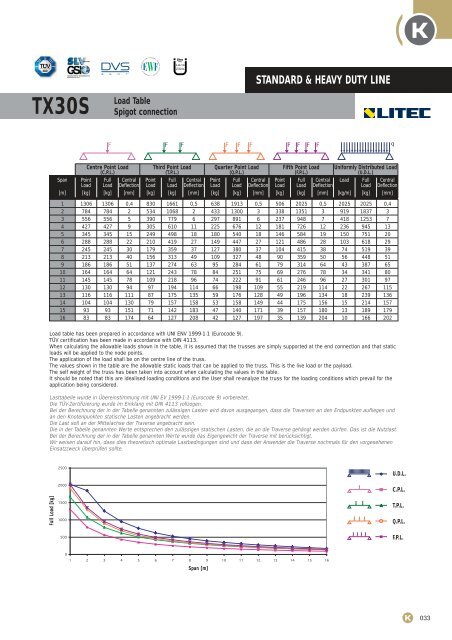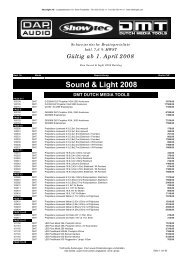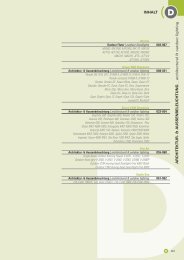standard & heavy duty line
standard & heavy duty line
standard & heavy duty line
You also want an ePaper? Increase the reach of your titles
YUMPU automatically turns print PDFs into web optimized ePapers that Google loves.
TX30S<br />
Load Table<br />
Spigot connection<br />
STANDARD & HEAVY DUTY LINE<br />
Load table has been prepared in accordance with UNI ENV 1999-1-1 (Eurocode 9).<br />
TÜV certification has been made in accordance with DIN 4113.<br />
When calculating the allowable loads shown in the table, it is assumed that the trusses are simply supported at the end connection and that static<br />
loads will be applied to the node points.<br />
The application of the load shall be on the centre <strong>line</strong> of the truss.<br />
The values shown in the table are the allowable static loads that can be applied to the truss. This is the live load or the payload.<br />
The self weight of the truss has been taken into account when calculating the values in the table.<br />
It should be noted that this are idealised loading conditions and the User shall re-analyze the truss for the loading conditions which prevail for the<br />
application being considered.<br />
Lasttabelle wurde in Übereinstimmung mit UNI EV 1999-1-1 (Eurocode 9) vorbereitet.<br />
Die TÜV-Zertifizierung wurde im Einklang mit DIN 4113 vollzogen.<br />
Bei der Berechnung der in der Tabelle genannten zulässigen Lasten wird davon ausgegangen, dass die Traversen an den Endpunkten aufliegen und<br />
an den Knotenpunkten statische Lasten angebracht werden.<br />
Die Last soll an der Mittelachse der Traverse angebracht sein.<br />
Die in der Tabelle genannten Werte entsprechen den zulässigen statischen Lasten, die an die Traverse gehängt werden dürfen. Das ist die Nutzlast.<br />
Bei der Berechnung der in der Tabelle genannten Werte wurde das Eigengewicht der Traverse mit berücksichtigt.<br />
Wir weisen darauf hin, dass dies theoretisch optimale Lastbedingungen sind und dass der Anwender die Traverse nochmals für den vorgesehenen<br />
Einsatzzweck überprüfen sollte.<br />
Full Load [kg]<br />
Span Point Full Central Point Full Central Point Full Central Point Full Central Load Full Central<br />
Load Load Deflection Load Load Deflection Load Load Deflection Load Load Deflection Load Deflection<br />
[m] [kg] [kg] [mm] [kg] [kg] [mm] [kg] [kg] [mm] [kg] [kg] [mm] [kg/m] [kg] [mm]<br />
1 1306 1306 0,4 830 1661 0,5 638 1913 0,5 506 2025 0,5 2025 2025 0,4<br />
2 784 784 2 534 1068 2 433 1300 3 338 1351 3 919 1837 3<br />
3 556 556 5 390 779 6 297 891 6 237 948 7 418 1253 7<br />
4 427 427 9 305 610 11 225 676 12 181 726 12 236 945 13<br />
5 345 345 15 249 498 18 180 540 18 146 584 19 150 751 20<br />
6 288 288 22 210 419 27 149 447 27 121 486 28 103 618 29<br />
7 245 245 30 179 359 37 127 380 37 104 415 38 74 519 39<br />
8 213 213 40 156 313 49 109 327 48 90 359 50 56 448 51<br />
9 186 186 51 137 274 63 95 284 61 79 314 64 43 387 65<br />
10 164 164 64 121 243 78 84 251 75 69 276 78 34 341 80<br />
11 145 145 78 109 218 96 74 222 91 61 246 96 27 301 97<br />
12 130 130 94 97 194 114 66 198 109 55 219 114 22 267 115<br />
13 116 116 111 87 175 135 59 176 128 49 196 134 18 239 136<br />
14 104 104 130 79 157 158 53 158 149 44 175 156 15 214 157<br />
15 93 93 151 71 142 183 47 140 171 39 157 180 13 189 179<br />
16 83 83 174 64 127 208 42 127 197 35 139 204 10 166 202<br />
2500<br />
2000<br />
1500<br />
1000<br />
500<br />
0<br />
Centre Point Load<br />
(C.P.L.)<br />
Third Point Load<br />
(T.P.L.)<br />
Quarter Point Load<br />
(Q.P.L.)<br />
Fifth Point Load<br />
(F.P.L.)<br />
1 2 3 4 5 6 7 8 9 10 11 12 13 14 15 16<br />
Span [m]<br />
Uniformly Distributed Load<br />
(U.D.L.)<br />
U.D.L.<br />
C.P.L.<br />
T.P.L.<br />
Q.P.L.<br />
F.P.L.<br />
K<br />
K<br />
033








